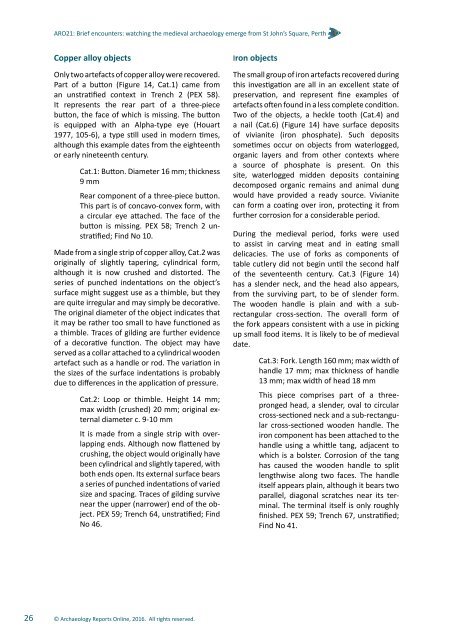medieval archaeology emerge from St John’s Square Perth
ARO21_St_Johns_Square
ARO21_St_Johns_Square
You also want an ePaper? Increase the reach of your titles
YUMPU automatically turns print PDFs into web optimized ePapers that Google loves.
ARO21: Brief encounters: watching the <strong>medieval</strong> <strong>archaeology</strong> <strong>emerge</strong> <strong>from</strong> <strong>St</strong> <strong>John’s</strong> <strong>Square</strong>, <strong>Perth</strong><br />
Copper alloy objects<br />
Only two artefacts of copper alloy were recovered.<br />
Part of a button (Figure 14, Cat.1) came <strong>from</strong><br />
an unstratified context in Trench 2 (PEX 58).<br />
It represents the rear part of a three-piece<br />
button, the face of which is missing. The button<br />
is equipped with an Alpha-type eye (Houart<br />
1977, 105-6), a type still used in modern times,<br />
although this example dates <strong>from</strong> the eighteenth<br />
or early nineteenth century.<br />
Cat.1: Button. Diameter 16 mm; thickness<br />
9 mm<br />
Rear component of a three-piece button.<br />
This part is of concavo-convex form, with<br />
a circular eye attached. The face of the<br />
button is missing. PEX 58; Trench 2 unstratified;<br />
Find No 10.<br />
Made <strong>from</strong> a single strip of copper alloy, Cat.2 was<br />
originally of slightly tapering, cylindrical form,<br />
although it is now crushed and distorted. The<br />
series of punched indentations on the object’s<br />
surface might suggest use as a thimble, but they<br />
are quite irregular and may simply be decorative.<br />
The original diameter of the object indicates that<br />
it may be rather too small to have functioned as<br />
a thimble. Traces of gilding are further evidence<br />
of a decorative function. The object may have<br />
served as a collar attached to a cylindrical wooden<br />
artefact such as a handle or rod. The variation in<br />
the sizes of the surface indentations is probably<br />
due to differences in the application of pressure.<br />
Cat.2: Loop or thimble. Height 14 mm;<br />
max width (crushed) 20 mm; original external<br />
diameter c. 9-10 mm<br />
It is made <strong>from</strong> a single strip with overlapping<br />
ends. Although now flattened by<br />
crushing, the object would originally have<br />
been cylindrical and slightly tapered, with<br />
both ends open. Its external surface bears<br />
a series of punched indentations of varied<br />
size and spacing. Traces of gilding survive<br />
near the upper (narrower) end of the object.<br />
PEX 59; Trench 64, unstratified; Find<br />
No 46.<br />
Iron objects<br />
The small group of iron artefacts recovered during<br />
this investigation are all in an excellent state of<br />
preservation, and represent fine examples of<br />
artefacts often found in a less complete condition.<br />
Two of the objects, a heckle tooth (Cat.4) and<br />
a nail (Cat.6) (Figure 14) have surface deposits<br />
of vivianite (iron phosphate). Such deposits<br />
sometimes occur on objects <strong>from</strong> waterlogged,<br />
organic layers and <strong>from</strong> other contexts where<br />
a source of phosphate is present. On this<br />
site, waterlogged midden deposits containing<br />
decomposed organic remains and animal dung<br />
would have provided a ready source. Vivianite<br />
can form a coating over iron, protecting it <strong>from</strong><br />
further corrosion for a considerable period.<br />
During the <strong>medieval</strong> period, forks were used<br />
to assist in carving meat and in eating small<br />
delicacies. The use of forks as components of<br />
table cutlery did not begin until the second half<br />
of the seventeenth century. Cat.3 (Figure 14)<br />
has a slender neck, and the head also appears,<br />
<strong>from</strong> the surviving part, to be of slender form.<br />
The wooden handle is plain and with a subrectangular<br />
cross-section. The overall form of<br />
the fork appears consistent with a use in picking<br />
up small food items. It is likely to be of <strong>medieval</strong><br />
date.<br />
Cat.3: Fork. Length 160 mm; max width of<br />
handle 17 mm; max thickness of handle<br />
13 mm; max width of head 18 mm<br />
This piece comprises part of a threepronged<br />
head, a slender, oval to circular<br />
cross-sectioned neck and a sub-rectangular<br />
cross-sectioned wooden handle. The<br />
iron component has been attached to the<br />
handle using a whittle tang, adjacent to<br />
which is a bolster. Corrosion of the tang<br />
has caused the wooden handle to split<br />
lengthwise along two faces. The handle<br />
itself appears plain, although it bears two<br />
parallel, diagonal scratches near its terminal.<br />
The terminal itself is only roughly<br />
finished. PEX 59; Trench 67, unstratified;<br />
Find No 41.<br />
26<br />
© Archaeology Reports Online, 2016. All rights reserved.


